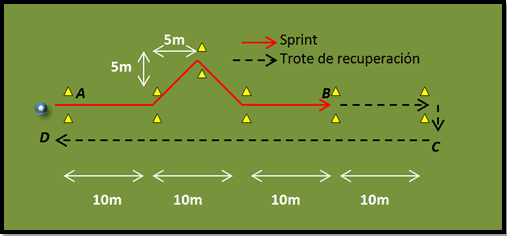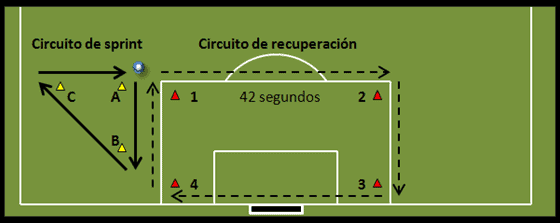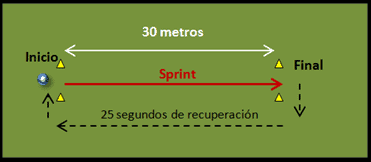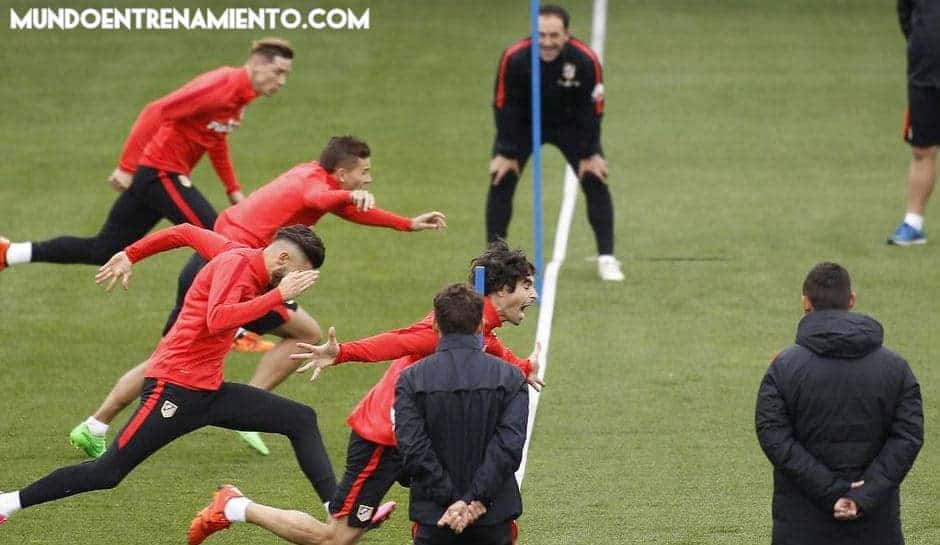The purpose of this article is none other than to refute that training the ability to repeat sprints (RSA) improves the performance of a soccer player.
The popularity and profile of team sports worldwide ensure that RSA training will remain an important exercise model for future research, trying to discover the best way to develop it in each of the team sports to seek the highest performance of the players, “to measure is to know” (1).
The RSA test encompasses a series of sprints that result in certain metabolic and cardiorespiratory responses similar to those that occur during the most demanding periods of matches (2).
A standard RSA training consists of performing 7 sprints of 30 meters with 24 seconds of passive recovery between them (1 sprint every 30s) (3).
This standard RSA training, in my understanding, has no place in soccer since in a match you never perform 7 consecutive sprints in an estimated time of 3’30”, which is the duration of this type of training.
However, we could use this type of training if our goal is to work on “alactic anaerobic power” endurance (work of 0-7” with maximum recovery) (4). But our goal is not only to improve this type of conditional capacity but to improve all the physiological resources that our body demands in a soccer match.
Seeking specificity in this type of work. Proposal for adapted RSA training
As we already know, soccer is an intermittent sport, (2) in which players vary the intensity and volume of their efforts based on external conditions that vary according to the match (6). This is why we must design an adapted RSA with the following phases that occur in the development of a soccer match “walk-jog-stride-sprint”.
The results obtained in the article “Validity of a repeated-sprint ability test in young soccer players” tell us that approximately every 3500 m covered (data from a 45’ half) only about 500m are at speeds higher than 13 km/h (what we would consider as Sprint). That is, the percentage in sprint is 14.29% of the number of meters covered (1).
Researching the topic, we found approximate percentages of the phases mentioned above that occur in a soccer match:
According to Davis (1992) (1) “the soccer player walks during a match 24.8% of the minutes, jogs 36.7%, and runs submaximally 20.9%”
We have transferred these percentages to the previously mentioned article and obtained the following results:
- Walk (24.8%) = 3500*0.248 = 868m will be done walking.
- Jog (36.7%) = 3500*0.367 = 1,284.5m will be done jogging.
- Stride (20.9%) = 3500*0.209 = 731.5m will be done in submaximal runs.
- Sprint (14.29%) = 3500*0.1429 = 500m will be done at sprint (maximum intensity)
The sum of the 4 phases (walk-jog-stride-sprint) gives us 3,384m. The remaining 116m will be done running backward, which would be 3.31% of the meters covered during a 45’ half.
Following these data, we are going to develop an RSA that has a direct relationship with the phases or metabolic responses that the player develops during the competition and that can therefore be used in training to improve “soccer-specific endurance”. We will call this adapted RSA “RSA WJSS” (acronyms corresponding to the terms Walk, Jog, Stride, and Sprint).
Performing this “RSA WJSS training” with the percentages explained above over 100 meters, we proceed to calculate the meters to be covered in each phase:
- Walk: 25 meters
- Jog: 37 meters
- Stride: 21 meters
- Sprint: 14 meters
We can say that this exercise will be at the aerobic-anaerobic threshold (5), due to the constant changes of pace that will occur if the cycle is repeated several times, so the number of repetitions, series, and estimated recovery time will be related to lactic anaerobic capacity (45” – 2’) and aerobic power (2’- 4’), depending on the load that the coach has scheduled for that day, the task will be lengthened or shortened in relation to the working time.
We will then be working on a specific endurance for the team sport of soccer.
Therefore, a standard task of this exercise would be:
- Number of repetitions / duration per series: approximately 2’ (approximate time of the threshold between lactic anaerobic power and lactic anaerobic capacity)
- Number of series, working time: from 5 to 10 series depending on the load to be applied.
- Recovery time: incomplete 20-30’’ (when the heart rate drops below 120-130, so that it is interval work).
It is important to add that, depending on the team’s playing style or the player’s position, the order of WJSS can be altered, simulating their effort in the competition.
Example, practical case
A forward from a team with a direct playing style, looking for counterattack actions in defense-attack transition. The exercise should be proposed as follows:
1st Walk: since the forward will be walking waiting for a counterattack action.
2nd Sprint: simulating the counterattack action
3rd Stride and 4th Jog: lowering the intensity from more to less once the counterattack action has ended.
Contextualization of the exercise
Seeking even more specificity of the exercise, and delving into what would be the real game actions, we can add in any of the marked spaces Walk, Jog, Stride, or Sprint typical movements of the soccer player in a match or training.
That is, we can add feints, changes of direction or COD (Change of direction), small jumps over hurdles and obstacles, or even movements or technical actions that require the use of the ball, such as dribbling, changes of pace with the ball, passes, or some type of striking.
All imagination is little, colleagues, following these guidelines, we can perform a quality task that improves the specific endurance of the soccer player and respects the model or game guidelines proposed by the coaching staff during the sessions.
Evaluation of RSA training
Soccer is a sport in which high-intensity actions occur interspersed with incomplete recovery times (7). Therefore, players must be adapted to this demand of the competition, with adequate preparation to perform sprints repeatedly during the competition.
The Repeated Sprint Ability or RSA is the ability to perform a certain number of high or maximum intensity efforts, of brief duration, less than 10 seconds, that are repeated over time randomly and with incomplete recovery periods, generally less than 1 minute and a half, that appear during the total time of the competition (8).
Thus, RSA can be understood as the ability of a soccer player to recover and maintain maximum effort during subsequent sprints (9), and it is considered a determining factor in soccer (10). Therefore, it is advisable to orient the training process to improve this parameter and, in addition, it will be very helpful to perform an evaluation of RSA training at different times throughout the season.
RSA field tests have shown great validity and reliability for the evaluation of the specific endurance of the soccer player (11, 12). They are based on the execution of short displacements (< 40 m), which are repeated a number of times (between 8-10 repetitions maximum), interspersing active or passive recovery (between 20-30 seconds) (13).
These RSA tests must meet certain criteria to be successfully carried out: The sum of the repeated efforts must not exceed a work volume of 300 meters (14); the duration of each repeated effort must be 4 to 6 seconds (9,10); and the recovery of each repeated effort must be incomplete, with a correct proportion between work and recovery around 1:5 (6 seconds of work, 30 of recovery) (17).
RSA training test
For the evaluation of RSA, we have different tests, proposed by various authors over the last few years.
Bangsbo test
The Bangsbo Test (18) consists of performing 7 repetitions of running at maximum intensity (34.2m), with active recovery pauses of 25 seconds between each repetition.
The course begins with a maximum sprint from point A to point B. The first 10 m are in a straight line until reaching the first pair of cones, there the subject makes a change of direction passing between another pair of cones arranged 5 m to the side and 5 m in front of the running line, then returns to the initial running line for another 10 m, until reaching point B.
The subject must continue jogging at low intensity passing through point C and returning to the starting line (point D)

Balsom test
The Balsom Test (19) consists of covering a triangle (A-B-C) of 9.1 meters per side at the highest possible speed. Subsequently, there are 42 seconds of active rest performed in a recovery circuit located next to the triangle. This circuit will be repeated 20 consecutive times by the player.

Other tests
Other authors have proposed different RSA training tests from the two above, designed to be executed in a straight line:
- 8 x 35 m with 30 s recovery (20)
- 6 x 40 m with 24 s recovery (21)
- 7 x 30 m with 20 s recovery (22)
- 8 x 30 m with 25 s recovery (23)

Determination of RSA training performance
Performance is determined by values such as the best time in a sprint (Best RSA Training) (24), the total time spent performing the sprints (Total RSA Training) (25, 26), and the average time of the sprints performed (Average RSA Training) (24). In addition, fatigue indices such as Sdec (percentage of decrease) (27) and Change (difference between first and last sprint) (26) are used.
Sdec= (Total time/Best sprint*number of repetitions)*100-100
Change= 100*((Last-First)/First)
There is a discussion about which is the best performance indicator of these tests. Some consider Total RSA Training, others Average RSA Training, and others the percentage of decrease.
But the only parameter that shows an acceptable absolute and relative reliability for monitoring is Average RSA Training (22), because a good RSA Training is better described by high performance in the average sprint, with or without a fatigue index (28).
Example of RSA training evaluation
Below I show the results of a field test of RSA Training carried out with two players of different profiles. The test consists of performing 8 sprints of 30 meters with 25 seconds of active recovery between each sprint.

Conclusions on RSA training
- RSA field tests are a good tool to assess the ability to repeat sprints of soccer players.
- These tests must meet certain criteria to be successfully carried out (distance, duration, number of repetitions, and recovery).
- We can design our own test, as long as it meets the requirements.
- The only parameter that shows absolute and relative reliability to determine performance is Average RSA Training.
- Traditional RSA does not improve the performance of the soccer player as it is far from the real context of a match.
- Only 14.29% of actions in a soccer match are performed at high intensity (sprint).
- Effort types must be adapted to the team’s playing model.
- The conditions of adapted RSA training must vary according to the player’s characteristics and position, seeking the greatest possible specificity.
Bibliography
- Brian, D, (2012) “Repeated-Sprint Ability: Where we are?” International Journal of Sports Physiology and Performance. p. 285-289
- Casamichana, D., San Román, J., Calleja, J., Castellano, J. (2015) “Small-sided games in soccer training” p. 69-94
- Alvarez, C. (1983). “Physical preparation for soccer based on athletics”.
- Lago Peñas, C. (2002). “Physical preparation in soccer”.
- Garcia, J. M. (1996).”Theoretical bases of sports training. Principles and applications”.
- Seirul-lo, F. (1993). “Training planning in team sports”. Master in High-Performance Sports. Module 2.1.7. COE-Autonomous University of Madrid.
- Arjol, J. L., Gonzalo, O. (2012). Reflections on RSA (Repeated Sprint Ability) training in soccer. Journal of Physical Preparation in Soccer, 4: 12-25.
- Barbero, J., Méndez-Villanueva, A., & Bishop, D. (2006b). The ability to repeat maximum intermittent efforts: physiological aspects. Part II. Evaluation and performance. Archives of Sports Medicine, 115, 379-390.
- Turner, A. (2013). Repeat Sprint Ability. Strength & Conditioning Journal, 35 (1), 37-41.
- Iaia, F. M., Rampinini, E., & Bangsbo, J. (2009). High-intensity training in football. International Journal of Sports Physiology and Performance, 4 (3), 291-306.
- Psotta, R., Blahus, P., Cochrane, D. J., & Martin, A. J. (2005). The assessment of an intermittent high-intensity running test. Journal of Sports Medicine and Physical Fitness, 45(3), 248-256.
- Wragg, C. B., Maxwell, N. S., & Doust, J. H. (2000). Evaluation of the reliability and validity of a soccer-specific field test of repeated sprint ability. European Journal of Applied Physiology, 83(1), 77-83.
- Girard, O., Méndez-Villanueva, A., & Bishop, D. (2011). Repeated-sprint ability – part I: Factors contributing to fatigue. Sports Medicine, 41(8), 673-694.
- Fitzsimons, M.; Dawson, B.; Ward, D. and Wilkinson, A. (1993). Cycling and running test of repeated sprint ability. Australian Journal of Science and Medicine of Sport. 25 (4), 82-87.
- Dawson, B.; Fitzsimons, M. and Ward, D. (1993). The relationship of repeated sprint ability to aerobic power and performance measures of anaerobic work capacity and power. Australian Journal of Science and Medicine of Sport 25(4), 88-93.
- Gaitanos, G. C.; Williams, C.; Boobis, L. H. and Brooks, S. (1993). Human muscle metabolism during intermittent maximal exercise. Journal Applied Physiology. 75 (2), 712-719.
- Sánchez, J., Blázquez, F., Gonzalo, A., Yagüe, J. M. (2005). Speed endurance as a conditioning factor for soccer player performance. Apunts physical education and sports, 3(81), 47-60.
- Bangsbo, J. (1998). Physical condition training in soccer. Paidotribo: Barcelona.
- Balsom, P. (1993). Field test to evaluate the ability of repeated accelerations of soccer players. Journal of Sports Training, 7(2), 35-40.
- Rushall B, Pyke F. (1990). Training for Sports and Fitness. Melbourne, McMillian.
- Fitzsimons M, Dawson B, Ward D. (1993). Cycling and running tests of repeated sprint ability. Aust J Sci Med Sports; 25:82-7. Reilly T, Bangsbo J, Franks A. (2000). Anthropometric and physiological predispositions for elite soccer. J Sports Sci; 18:669-83.
- Oliver JL, Williams CA, Armstrong N. (2005). The reliability and validity of running tests of repeated sprint ability. J Sports Sci; 23:200-1.
- Impellizzeri, F. M., Rampinini, E., Castagna, C., Bishop, D., Ferrari Bravo, D., Tibaudi, A., & Wisloff, U. (2008). Validity of a repeated-sprint test for football. Int J Sports Med, 29(11), 899-905.
- Chaouachi, A., Manzi, V., Wong del, P., Chaalali, A., Laurencelle, L., Chamari, K., & Castagna, C. (2010). Intermittent endurance and repeated sprint ability in soccer players. Journal of Strength and Conditioning Research, 24(10), 2663-2669.
- Pyne, D. B., Saunders, P. U., Montgomery, P. G., Hewitt, A. J., & Sheehan, K. (2008). Relationships between repeated sprint testing, speed, and endurance. Journal of Strength and Conditioning Research, 22(5), 1633-1637.
- Spencer, M., Bishop, D., Dawson, B., & Goodman, C. (2005). Physiological and metabolic responses of repeated-sprint activities: specific to field-based team sports. Sports Medicine, 35(12), 1025-1044.
- Rodríguez-Fernández, A., Sánchez-Sánchez, J. and Villa-Vicente, J.G. (2013). Evolution of performance in repeated sprint ability (RSA) according to the time of the season and depending on the position in young soccer players. Journal of Physical Preparation in Soccer, 10: 13-23.
- Bishop, D., Girard, O., & Mendez-Villanueva, A. (2011). Repeated-sprint ability -part II: recommendations for training. SportsMed, 41(9), 741-756.
Collaborating author | Beñat Erkizia

